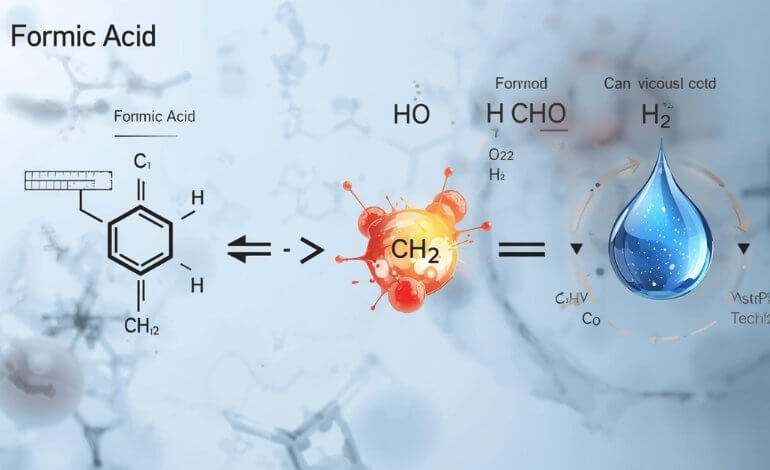
HCOOCH CH2 H2O Reaction Explained (2025): Complete Chemistry Guide
Chemistry can be hard to understand at times, especially when you see reactions written in a short form like HCOOCH CH2 H2O. At first, it might be hard to understand what these formulas mean and how they interact with each other. Don’t worry; we’ll explain it all in simple terms in this article.
We will first look at each compound on its own: HCOOH (formic acid), CH₂ (a chemical radical that is often confused), and H₂O (water). Then we’ll talk about how they can work together, what the possible balanced equations are, and what these reactions mean in real life, in business, and even in nature.
By the end, you’ll know not only what the reaction is, but also why it’s important, how it’s used, and what questions students and researchers often ask about it.
What is hcooch ch2 h2o ?
HCOOCH CH2 H2O is a mix of formic acid (HCOOH), methylene (CH₂), and water (H₂O). Formic acid is a simple organic acid that is found in ant venom and used in many industries. CH₂, on the other hand, is an unstable, highly reactive group that usually only exists for a short time during chemical reactions.
Water is a solvent that helps things react with each other. When these compounds come into contact with each other, they can make new organic molecules like formaldehyde (CH₂O) or methanol (CH₃OH) in some situations. But CH₂ doesn’t exist on its own in normal conditions, so scientists mostly study this reaction in labs or in discussions about theoretical chemistry.
Structure and Formula HCOOH (formic acid)
- Formula: HCOOH
- Structure: one carbon atom bonded to a hydrogen atom, a double-bonded oxygen atom, and a hydroxyl group (–OH).
- It belongs to the carboxylic acid family, which is known for the –COOH group.
Physical Properties
- Colorless liquid with a pungent smell.
- Miscible with water (it mixes easily).
- Stronger than acetic acid (vinegar), but weaker than mineral acids like HCl.
Chemical Properties
- Acts as both a reducing agent and an acid.
- Can decompose to release carbon monoxide (CO), carbon dioxide (CO₂), and water (H₂O) depending on conditions.
- Reacts with bases to form salts (formates).
Natural Occurrence
- Found in ants, bees, and stinging nettles.
- Plays a role in plant defense systems.
Industrial Production
- Produced as a byproduct in methanol and acetic acid industries.
- Also manufactured from carbon monoxide under high pressure.
Formic acid is a common chemical that is used in many reactions, as well as in textiles, leather processing, and as a preservative.
Does CH₂ It Really Exist?
CH₂ seems like a normal chemical formula at first, but the truth is a little more complicated. You can’t put CH₂ in a bottle because it isn’t a stable compound like H₂O (water) or HCOOH (formic acid). Instead, it usually shows up in chemistry as a radical or as part of bigger molecules. Yes, but not as a stable compound on its own. It can be a short-lived radical in reactions or a part of a bigger molecule.
CH₂ as a Radical (Methylene Radical)
- In free form, CH₂ is called a methylene radical.
- It has two unpaired electrons, which makes it extremely reactive.
- Because of this high reactivity, it only exists for a very short time under special laboratory conditions.
CH₂ in Organic Molecules
- CH₂ is often written as a group inside bigger molecules.
- Example: Ethane (C₂H₆) has two CH₃ groups. If you remove one hydrogen from CH₃, you get a CH₂ group.
- You’ll see CH₂ units repeated in hydrocarbons like polyethylene (plastic): –CH₂–CH₂–CH₂–
Common Confusion: CH₂ vs. CH₂O
- Many beginners confuse CH₂ with CH₂O (formaldehyde).
- CH₂O is a stable compound used in industries (especially in making resins and disinfectants).
- CH₂, however, is just a fragment or radical, not a stable substance on its own.
What is H₂O (Water)?
H₂O is the chemical name for water, which is one of the most important things for life on Earth. When we see H₂O, it’s always in the form of liquid water, ice, or steam. But in chemistry, it has some very special properties that make it stand out.
Structure of H₂O
- Water is made of two hydrogen atoms bonded to one oxygen atom.
- The oxygen atom pulls electrons more strongly than hydrogen, making water a polar molecule.
- This polarity is the reason water can dissolve so many substances — which is why it’s often called the “universal solvent.”
Physical Properties
- Colorless, tasteless, and odorless in pure form.
- Exists naturally in all three states: solid (ice), liquid (water), and gas (steam/vapor).
- Has a high boiling point and melting point compared to similar molecules, thanks to hydrogen bonding.
Role in Chemical Reactions
- Water is not just a product of reactions — it can also act as a reactant.
- It participates in hydrolysis (breaking molecules with water) and condensation reactions (where water is released as a byproduct).
- In the reaction we are studying (HCOOH + CH₂), water often appears as a byproduct when bonds are formed or broken.
Biological Importance
- Every living organism depends on water for survival.
- It helps maintain temperature, transport nutrients, and supports countless biochemical reactions in cells.
Industrial and Environmental Role
- Used in cooling systems, energy production, cleaning, and almost every industry.
- Plays a important role in weather, climate, and sustaining ecosystems.
Read ALSO : Mike Wolfe Passion Project: all about it Life
Talk about the Reaction of HCOOH + CH₂ + H₂O

When you see an equation like HCOOH + CH₂ + H₂O, it can be a little bit confusing at first. Let’s break it down step by step to understand what’s really happening.
Is This Reaction Correct as Written?
- HCOOH is formic acid.
- CH₂ is not a stable standalone molecule — it usually exists as a radical or within larger compounds.
- H₂O is water.
- In chemistry, simple equations are sometimes used to show processes in a reaction or to make it easier to understand.
So viewers , this reaction is not a standard textbook equation, but it represents a decomposition or interaction process where water is involved.
Balanced Chemical Equation Possibility
One common reaction involving formic acid is its thermal decomposition:
HCOOH→CO+H2O
- Here, formic acid breaks down into carbon monoxide (CO) and water (H₂O).
- This reaction happens when it’s hot or when chemicals are around.
Another possibility:
HCOOH→CO2+H2
- In this version, formic acid produces carbon dioxide (CO₂) and hydrogen gas (H₂).
In both cases, water (H₂O) often appears as a byproduct or part of the mechanism.
Reaction Mechanism (Simplified)
- Formic acid contains both a hydrogen atom and a carboxyl group, making it prone to decomposition.
- When heat or catalysts are applied, bonds break, leading to small molecules like CO, CO₂, H₂, and H₂O.
- The CH₂ radical may appear as a short-lived intermediate during the breakdown process, but it quickly converts into more stable products.
Experimental Conditions
- Heat: Thermal decomposition of HCOOH usually requires temperatures above 100°C.
- Catalysts: Metal catalysts (like platinum) can change the pathway, favoring CO₂ + H₂ production.
- Solution State: In water, HCOOH can ionize and react differently depending on pH.
Final Statement about it
The reaction HCOOH + CH₂ + H₂O is often a simplified way of representing how formic acid decomposes or reacts in the presence of water and unstable CH₂ intermediates. The main stable products are usually CO + H₂O or CO₂ + H₂, depending on conditions.
Applications and Importance
The reaction of HCOOCH CH2 H2O (formic acid) with things like CH₂ and the making of H₂O may seem like pure chemistry, but it is very important in labs, businesses, and even nature. Let’s break it separate.
Industrial Uses of Formic Acid Reactions
- Textile & Leather Industry: Formic acid is widely used for tanning leather and dyeing textiles because of its acidity and antibacterial properties.
- Preservatives & Silage Treatment: Farmers use diluted formic acid to keep animal feed from growing bacteria.
- Cleaning & Descaling: It’s a weak acid, so it’s used to clean metal surfaces, get rid of rust, and make cleaning products for the home.
Role in Organic Development
- Hydrogen Source: The transformation of HCOOH into CO₂ + H₂ provides a clean hydrogen source, which is important for green energy research.
- Intermediate Production: CH₂ radicals formed during reactions can lead to the creation of other organic molecules like alcohols, aldehydes, and acids.
- Catalysis Research: Scientists look at these reactions to make better reactions for fuel cells and energy storage.
Importance for the environment and living things
- In Nature: Ants, bees, and stinging nettles naturally produce formic acid as a defense mechanism.
- In Ecosystems: The breakdown of HCOOH into CO₂ and H₂O shows how nature recycles small molecules.
- In Biology: Formic acid can appear in human metabolism in very small amounts (especially when methanol is processed in the body).
Safety Precautions When Handling Formic Acid
Formic acid (HCOOCH CH2 H2O) is useful in a lot of different fields, but you have to be careful with it because concentrated solutions can eat away at things and hurt your skin, eyes, or lungs. To avoid breathing in harmful fumes, always wear gloves, goggles, and a lab coat. Also, work in a well-ventilated area or under an exhaust hood.
It should be kept in tightly sealed containers made of materials that won’t break down easily, and it should be kept away from heat, flames, and strong oxidizers. If you come into contact with it, wash your skin or eyes right away with a lot of water and see a doctor if you need to.
If you breathe it in, you should go outside to get fresh air. If you take in it, you should see a doctor right away without throwing up. Workers should get the right training, and there should be emergency showers or eye-wash stations available to make sure they can handle things safely.
Conclusion
Final note, the formula HCOOCH CH2 H2O may seem hard to understand, but once you do, it shows how small molecules interact and make new things. Formic acid (HCOOH) is a simple but strong organic acid that can turn into gases like carbon monoxide, carbon dioxide, and hydrogen.
Water (H₂O) is often involved in this process. CH₂ is not stable by itself, but it is a reactive part of many organic reactions. By studying this reaction, we can learn about important chemical processes that are used in industries like textiles, leather, and making clean energy.
It reminds us that even tiny molecules can have a big impact on science, nature, and technology. People look for Wonka showtimes to see a magical story, and chemists look for reactions like these to find the amazing things that are hidden in chemistry.
Faqs
No. CH₂ is not stable on itself; instead, it only exists as a short-lived radical in chemical reactions. It reacts right away and combines with other atoms or molecules to make something more stable when conditions are normal.
When formic acid is mixed with water, it reduces down into H⁺ (protons) and HCOO⁻ (formate ions). This makes the solution more acidic. To put it another way, formic acid in water acts like a weak acid, which lowers the pH.
Yes. When HCOOH is in certain situations, it can break down into CO₂ and H₂ (hydrogen gas). In other situations, it can make CO + H₂O. The exact products depend on the temperature and the catalysts.
In organic chemistry, water is often made as a byproduct because many reactions involve either condensation (removing water when molecules join) or decomposition (where oxygen and hydrogen atoms come together to make water).
Yes, strong formic acid can eat through things and hurt your skin, eyes, or lungs. But when it is diluted, it is safe to use in a lot of things, like cleaning products, leather processing, and food preservation.
In industries that make leather, textiles, and preservatives.
In energy research, to make hydrogen from formic acid.
Formic acid is a defense mechanism that some plants and ants use in nature.


